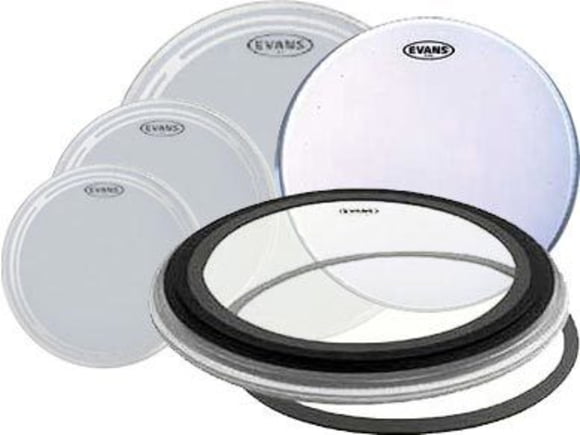10. Heads
Batter Heads
Natural skin used to be the material of choice for most drum kits in the past. Today, however, you will find them only on percussion instruments. Congas, for example, normally feature buffalo skin, djembas and other handheld drums goat skins, but fish or pig skins are also found.
Due to its greater durability, modern drum heads for the most part consist of a single or double layer of synthetic material. Batter heads are slightly thicker, while thinner layers are used on the resonant head for optimum transmission of the vibration.
The distinction between coated and clear surfaces is important for the sound quality. Since the choice of head is crucial for the sound of your drum, we recommend that you try the different types of head on your own setup. Many drummers probably know the feeling of surprise when their drum set sounds completely different with a new set of heads! Generally, double-layer heads offer slightly more muting, more pressure and "punch". Clear double layer heads also feature slightly more attack, while the coated version sounds a bit warmer. Double-layer heads are therefore suitable for those drummers who enjoy really getting into it and who may at times strike the heads that little bit harder.
A more muted manner of playing which brings the natural sound of a drum to the forefront is best supported by single-layer heads. Single-layer coated heads have become the standard solution for snare drums. Their slightly buffed surface also allows for distinctively jazzy brush play. Snare heads with damper rings integrated into the edges, or additional dampers (dots) in the centre are becoming more and more popular. They result in a drier snare drum sound.
Base drums are usually fitted by the manufacturer with a sturdy double layer head. These are better suited to survive the stress of a bass drum beater for longer and deliver a proper punch. There are a number of different models available with additional mute rings as well. Using a single-layer head, you can create a markedly more quiet and open sound, without however developing the same degree of pressure.
NOTE: Those who expect as much punch as possible from their bass drum should opt for multi-layer heads with additional dampers. If you prefer a more natural, and above all quieter sound, single-layer heads are the right choice for you.
Resonant Heads
Resonant heads on toms are usually clear single-layer heads. In order to ensure the best possible resonance, they are a little thinner than the corresponding batter heads. But you should never use them as replacement for your batter heads, since the sticks would quickly leave unsightly dents on the thinner surface! Snare drum resonant heads are particularly delicate to ensure the best possible resonance of the snare strainer affixed to the bottom of the drum.
Bass drum resonant heads are either completely closed or feature a hole of 8" to 10" diameter, positioned either dead center of off-center to the side. Nowadays you also have the choice of resonant heads with a number of smaller holes - to identical effect.
Closed heads result in a voluminous bass sound, combined with a longer sustain. The hole makes the sound shorter and tighter. Furthermore, if there is a hole in the resonant head a mic can be placed inside the drum.
But the hole also affects the way you play your drum. When you employ the so-called "heel up" technique, the bass drum beater remains on the batter head after each drum beat, rather than being retracted. thanks to the hole the air can escape rather than being thrown back against the batter head. This means there is none of the "fluttering" of the beater you get without a hole.


